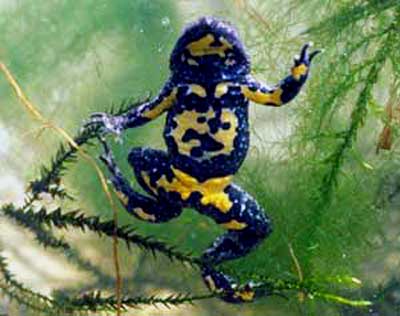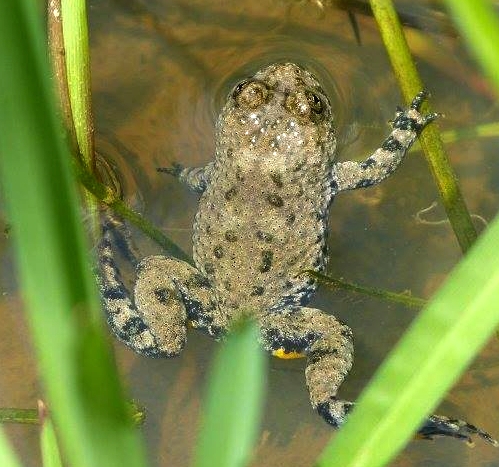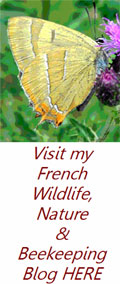Yellow bellied toad
Bombina Variegata
Sonneur à ventre jaune
A small toad with a maximum size of 5cm which are easily recognisable by their brightly coloured undersides, limbs and throat which are yellow with black marbling. Their backs are from greyish brown to greenish brown and are warty, their eyes are protruding with a pupil that is more or less triangular or heart shaped. The digits on the front legs are not webbed, whereas the digits on the back legs are almost totally webbed.
Their main range in France is between a line drawn from Loire Atlantique to Ardennes and a line drawn between Vendee and Côte D'Azur giving a more or less triangular area. Their habitat is comprised of ponds, ditches, canals, ruts, forest ponds, old quarries and drinking troughs. They are generally aquatic and rarely stray from the waterside. They prey on worms, mollusks, small crustaceans, insects and their larva, occasionally spiders. They are generally gregarious and often live in small diurnal groups. When threatened they turn over on their backs and expose their coloured bellies as a warning to any predator that their flesh is it not edible. The males sing both day and night, as they do not have a vocal sac the sound does not carry very far, perhaps 10 metres.
Coupling begins in April and continues until July or August depending upon altitude and temperature. Females lay several batches of around ten eggs in aquatic vegetation and can produce 2 or 3 broods a season with perhaps a total of 300 eggs. The development of the young is quite rapid being complete within three months. This is extremely important as many of the places the eggs are laid are shallow and dry completely in summer.
They have a close cousin which are to be found in Eastern Europe, the Fire bellied toad Bombina bombina and although this species has a completely different mating procedure and the fire bellied toad has vocal sacs the two species interbreed where they are both present. The offspring can resemble either species, are fertile and able to reproduce.
Threats are principally the filling of small pools, land use change, land drainage and the mechanical clearing of ditches from April until October when the toads are present.





